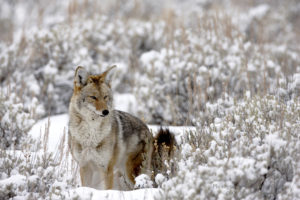How killing wildlife in the United States became a game

Note: Coyote photo added to this page, by local WY photographer Tim Mayo.
Hunting competitions to kill wild animals such as coyotes, bobcats, raccoons, skunks, and foxes for money and prizes are increasingly controversial. Eight states have outlawed them, and legislation introduced recently in Congress aims to ban them on public lands.
PHOTOGRAPHS BELOW BY KARINE AIGNER
PUBLISHED APRIL 27, 2022
LIBERTY, NEW YORK
Hunkered down in a camouflaged hut at dawn, Timothy Kautz trains his rifle on a deer carcass laid as bait in a snow-covered valley abutted by swamp and forest. Glancing at his cell phone, he reviews a recent remote camera video showing a grayish brown canine with pointy ears, a long, narrow muzzle, and a bushy tail snatching some venison.
So far this February morning, the coyote is a no-show.
“Maybe he’s seen too many of his friends shot here,” Kautz says, warming his hands by a portable gas space heater as fluffy snowflakes swirl outside the window. “He was probably sitting nearby when I got one of his buddies.”
Picture of people registering for coyote killing contest
Each year in February, participants in the three-day Sullivan County hunt, in New York State’s Catskill Mountains, compete to kill the most and biggest coyotes across the state and several counties in Pennsylvania and New Jersey. Some proceeds from hunt entry fees fund…Read More
A deputy in the Sullivan County Sheriff’s Office in New York’s Catskill Mountains, Kautz, 42, is participating in an annual three-day weekend tournament in which nearly 400 hunters are vying to win a $2,000 grand prize for killing the biggest coyote.
The United States is the only country in the world where wild animals are killed by the tens of thousands strictly for prizes and entertainment, according to the Humane Society of the United States. It estimates that before the coronavirus pandemic, there were more than 400 contests annually, accounting for an estimated 60,000 dead animals each year. Texas alone holds at least 60 contests annually. Many competitions offer an array of wildlife to shoot, from raccoons, squirrels, rabbits, and groundhogs to foxes, bobcats, stingrays, and crows. Coyotes, widely considered a nuisance animal across the country, are the most popular target. (Some states hold contents intended to reduce invasive wildlife, such as Burmese pythons in Florida, feral hogs in Texas, and nutria in Louisiana.)
The contests are increasingly controversial, criticized as blood sport. So far, eight states—Arizona, California, Colorado, Maryland, Massachusetts, New Mexico, Vermont, and Washington—have outlawed the contests under pressure from conservation and animal welfare groups. Calls for a national ban got louder after a 2020 undercover investigation by the Humane Society revealed the emergence of killing tournaments through members-only Facebook groups, raising questions about whether online contests violate state wildlife and gambling laws. In early April, Congressman Stephen Cohen, a Democrat from Tennessee, and 15 co-sponsors introduced a bill to ban contests on all public lands.
In past years, award-winning coyotes at the contest in the Catskills, co-hosted by the Federation of Sportsmen’s Clubs of Sullivan County and the White Sulphur Springs Volunteer Fire Department, weighed in at around 50 pounds. One of the first two coyotes Kautz shot this year registered 48.65 pounds. “It’s a big dog,” he says, though previous contests have taught him to temper his enthusiasm. “I always get beat by a few ounces. I hope I don’t get beat this year.”
If Kautz doesn’t win the grand prize, he could come away with $500 for second place or $250 for third. To be eligible, hunters must pay $35 to enter the contest, which covers the cost of a Sunday dinner banquet and a five-dollar raffle ticket. In addition to paying for prizes, contest proceeds fund outdoor programs for families and environmental conservation. Aside from the biggest awards, hunters compete for the day’s heaviest kill ($200), and there are separate prizes ($100 each) for women and children to win. For each qualifying coyote, hunters receive $80. Awards and raffle prizes are distributed at the banquet. The raffle prizes include firearms, ammunition, and high-tech calling devices that lure animals to hunters’ waiting guns. Kautz already has a plan for what he’ll do with the prize money if he wins.


